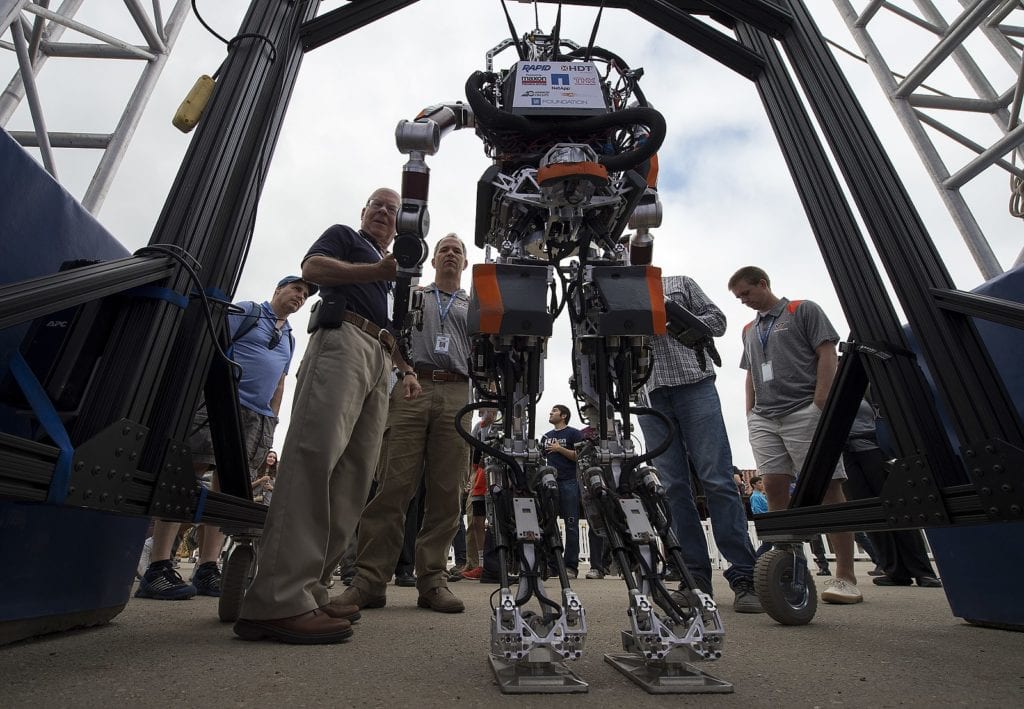How to Make Friends with Robots and Become a Superhero
How to Make Friends with Robots and Become a Superhero
- Last Updated: December 2, 2024
Marc Phillips
- Last Updated: December 2, 2024



There's a constant a stream of headlines repeating how machines are getting smarter every day. But there’s a human element here too. So many stories emphasize the “digital” and miss the real transformation that’s taking place. Here’s a look at some IoT examples in the analog world, the world of real people, and what truly is exciting about the internet of things.
Let’s start with Joe. He’s a service technician for a supplier of industrial refrigeration units. Joe’s got a schedule. He has a list of machines that he needs to keep running. It’s hot in Joe’s territory, and his machines hold everything from ice cream and antibiotics to steaks and tissue samples. If a unit fails, hundreds of thousands of dollars will literally go down the drain. So he visits them on a perpetual timeline, going from one to the other in order, checking for signs of trouble. He knows on average how long they can run without problems. But that’s on average. Some machines are on the verge of collapse when he gets there. Others never seem to need more than a light dusting. And, unfortunately, some break down unexpectedly and Joe has a bad day.
IoT Examples in the Real World
What can IoT do for Joe? What about for Lisa and Paul? Let's find out.Building a Better Joe
Joe visits each machine at the same regular interval. That’s not good. For starters, it means many machines are checked too often. More critically, a few machines aren’t checked often enough and sometimes fail before Joe’s next visit. Furthermore, the operating conditions for each machine change frequently as usage patterns shift and weather fluctuates. That makes time an even poorer predictor of time to failure.[caption id="attachment_35116" align="aligncenter" width="696"]

Joe needs just two things to transform his business (and his lifestyle). First, he needs to know the state of all his machines at any given time. Second, he needs access to this information from wherever he happens to be.
Joe: Hello, IoT.
IoT: Hello, Joe.
Joe doesn’t need a digital twin or machine learning. He doesn’t want blockchain or AI. The only thing that Joe requires is simple knowledge from a distance. What IoT does for Joe is tell him the temperature and other values, of all his machines, at any time. IoT sends a text to Joe’s phone whenever one of his machines starts getting warm or seems otherwise out of whack. It tells him whether the door is open or closed and if the power is on. He can resolve some issues with a quick call to the facility. He avoids many serious problems altogether by a quick turn of the wrench or proactive part replacement.
IoT means fewer failures and happier customers. Now he only visits machines showing early signs of trouble. Of course, Joe’s employer wants to keep him busy. Many companies find their growth limited by their capacity to service the equipment they sell. With IoT, Joe can keep more machines running reliably. This boosts the company’s quality reputation and fuels expansion. Each unit gets its own personal Joe watching for trouble 24/7. That’s pretty exciting, and we haven’t even said “predictive maintenance” yet.
Where Things Get Interesting
Remote monitoring made a big dent in Joe’s universe. Now let’s go up a level. Let’s say you’re Lisa, a distribution center manager responsible for loading refrigerated tractor-trailers each morning with groceries, medicines, and other perishable items to destinations around the country. How can IoT help you? Every morning you send someone into the truck yard to flip the “on” switch for each refrigeration unit. That lets the trailers pre-cool to the right temperature before it’s their turn to be loaded. But here’s the problem. You don’t always know when that will be. Some trucks take longer to load than others, depending on staff and cargo. Sometimes you have to wait for a delayed shipment to arrive and be unloaded beforehand. Half your fleet sits burning diesel fuel unnecessarily for hours every day cooling empty trailers. This adds up and hurts your bottom line, not to mention the planet.What if you could track the progress of the loading teams and incoming shipments, and accurately predict when each truck would be called to load? Then, what if you could press a button in your office to power up each unit and cool the next trailer down just in time. Better yet, have the system do it for you. That’s going to save a ton of fuel and waiting around. Lisa’s a lot happier in the morning now, but she’s still got problems.
I Don't Know What You're Talking About
Lisa is also responsible for making sure all those vegetables and chemicals reach their destinations safe and sound. Because of this, two scenarios keep her up at night. Her first nightmare is receiving an irate call from a supermarket manager claiming their frozen fish fillets were delivered warm. Did they thaw out in transit, or after delivery due to a problem at the store? Fortunately, IoT can tell her the exact temperature at each mile of the journey and ensure proper liability. Then there’s her second terror. It’s the lab supervisor asking why only half of their frozen nitrogen canisters arrived on the truck. Fortunately for Lisa, IoT locks the trailer doors automatically as soon as each truck leaves the geofence boundary of the distribution center, and IoT raises hell if anyone tries opening them before reaching the customer’s loading dock. No more shrugged shoulders or pointing fingers. For Lisa, IoT is much more effective than counting sheep.[caption id="attachment_34792" align="aligncenter" width="696"]

My Filters Are Better Than Your Filters
For our third and final example, we turn to the hidden domain of industrial fluid management. This is Paul’s world. He sells filtration systems to process manufacturing plants. The fluid loops at these facilities are multi-million dollar capital assets, making contamination costly. Paul has problems. He makes most of his revenue through replacement filters. His filters are good, but they’re expensive. So some customers buy cheaper knock-off filters that don’t work as well, and their fluid gets dirty. Then they call Paul and demand compensation. Unfortunately, Paul has no way to know what filters are being used in his system. However, IoT can tell Paul exactly which filter is in place at all times. IoT prevents shenanigans.But it’s not just about making more money for Paul. It’s about delivering better business outcomes for everyone. IoT saves Paul’s customers money. They’re notified when filters are becoming clogged and should be replaced, rather than on a set schedule. As with Joe’s freezers, fluctuations in operating environments make time alone a dangerous service metric. With a fixed interval, many filters are replaced too early, increasing overall operating costs. Worse, sometimes filters break down more quickly and fluid gets contaminated, causing huge losses for Paul’s customers.
IoT lets Paul use machine learning with algorithmic models to detect the early signs of contamination before problems occur. IoT immediately notifies Paul and the system operators to proactively solve the problem without ever stopping production. Now Paul is more valuable to his customers. They see him as a productivity partner rather than a commodity vendor. His competition may sell similar quality filters. Maybe even at better prices. But IoT and Paul provide an early warning system that his competition can’t match. Paul doesn’t sell filters. Paul guarantees clean fluid. That’s impressive.
Paul: Thank you, IoT.
IoT: You’re welcome, Paul.
Our Robot Overlords Can Wait
So you see, it’s not about the machines at all. It’s about Joe and Lisa. It’s about Paul, and all the other humans doing more with IoT. The result of smarter machines is more powerful people. IoT transformed Joe’s job of endless repetition and failures beyond his control into the role of true customer service. Before, Joe was the guy who showed up twice a year, took a look at your equipment, and handed you a bill. Sometimes he was the guy you yelled at on the phone as your inventory seeped slowly under the door. But IoT makes Joe the king of cool, your partner in keeping everything fresh and safe for your own customers. It’s just a completely different relationship, a more human relationship.IoT helps Lisa reduce chaos, mistrust, and waste. With IoT, Lisa transforms from cat herder to orchestra conductor. She sees the status of her entire operation at a glance. Furthermore, she keeps an audit trail of the past and gets actionable information from the future. All that her customers know is that Lisa always delivers.
Finally, there’s Paul. He was the guy to beat, a cost to be minimized. He always said his systems were better and his filters worth the price, but how could you really tell? Sure, when you lost that batch of product due to contamination you were using a cheaper filter jammed into Paul’s system, but you’re still not convinced his price means quality. These IoT examples show us ways to create whole new business models. Both you and Paul now share a common goal. Keep the fluid clean, at the lowest possible price, in perpetuity. The real value of IoT is allowing both teams to win every game.
Good Day, Human
That’s it. Digital twins, intelligent edges, and machine learning models are everywhere. Yes, the machines are getting smarter. So what? Joe, Lisa, and Paul are here to stay. IoT is the result of better machines—and that’s great. The exciting part is that IoT creates the possibility for better humans.The Most Comprehensive IoT Newsletter for Enterprises
Showcasing the highest-quality content, resources, news, and insights from the world of the Internet of Things. Subscribe to remain informed and up-to-date.
New Podcast Episode

The State of Smart Buildings
Related Articles


